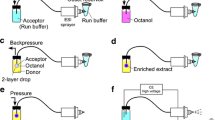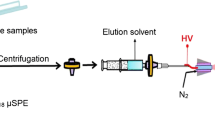Abstract
A miniaturised technique to analyse and detect heterocyclic aromatic amines (HAs) using micro solid-phase extraction (μSPE) coupled on-line (in-capillary) to capillary electrophoresis (CE) separation with nanospray (nESI) mass spectrometry (MS) detection has been developed. HAs are mutagenic and carcinogenic compounds formed at low levels in protein-rich food during cooking. Due to the low concentrations of HAs and the high complexity of the matrix in which they exist, sensitive and selective analytical methods are required for quantification. μSPE was performed on a packed bed of C18 particles inside the CE capillary, which minimised the dead volume. The on-line coupling of SPE, CE and nESI-MS reduced the time for extraction and identification to less than half an hour, which will allow for screening of several samples per day. The new technique provides short analysis time, low sample and solvent consumption, and HAs in standard solutions were easily detected at 12–17 fmol injections, and in spiked urine samples at 750–810 fmol injections.






Similar content being viewed by others
References
Sugimura T (2000) Carcinogenesis 21:387–395
Sugimura T (1997) Mutat Res 376:211–219
Sugimura T, Wakabayashi K, Nagao M, Esumi H (1993) A new class of carcinogens: heterocyclic amines in cooked food. In: Parke DV, Ioannides C, Walker R (eds) Food, nutrition and chemical toxicity. Smith-Gordon and Nishimura, London, pp 259–276
Felton JS, Knize MG (1990) Heterocyclic amine mutagens/carcinogens in foods. In: Cooper CS, Grover PL (eds) Handbook of experimental pharmacology. Springer, Berlin Heidelberg New York, pp 471–502
Skog KI, Johansson MA, Jägerstad MI (1998) Food Chem Toxicol 36:879–896
Nagao M (1999) Mutat Res 431:3–12
Zheng W, Gustafson DR, Sinha R, Cerhan JR, Moore D, Hong CP, Anderson KE, Kushi LH, Sellers TA, Folsom AR (1998) J Natl Cancer Inst 90:1724–1729
Norrish AE, Ferguson LR, Knize MG, Felton JS, Sharpe SJ, Jackson RT (1999) J Natl Cancer Inst 91:2038–2044
Sinha R, Kulldorff M, Chow WH, Denobile J, Rothman N (2001) Cancer Epidemiol Biomarkers Prev 10:559–562
Knize MG, Felton JS, Gross GA (1992) J Chromatogr 624:253–265
Gross GA, Philippossian G, Aeschbacher HU (1989) Carcinogenesis 10:1175–1182
Gross GA (1990) Carcinogenesis 11:1597–1603
Kataoka H (1997) J Chromatogr A 774:121–142
Frandsen H, Frederiksen H, Alexander J (2002) Food Chem Toxicol 40:1125–1130
Toribio F, Galceran MT, Puignou L (2000) J Chromatogr B Biomed Sci Appl 747:171–202
Pais P, Knize MG (2000) J Chromatogr B Biomed Sci Appl 747:139–169
Wu J, Wong MK, Li SFY, Lee HK, Ong CN (1995) J Chromatogr A 709:351–359
Puignou L, Casal J, Santos FJ, Galceran MT (1997) J Chromatogr A 769:293–299
Zhao Y, Schelfaut M, Sandra P, Banks F (1998) Electrophoresis 19:2213–2219
Tomlinson AJ, Guzman NA, Naylor S (1995) J Capillary Electrophor 2:247–266
Schellen A, Ooms B, van Gils M, Halmingh O, van der Vlis E, van de Lagemaat D, Verheij E (2000) Rapid Commun Mass Specrom 14:230–233
Petersson M, Wahlund K-G, Nilsson S (1999) J Chromatogr A 841:249–261
Strausbauch MA, Landers JP, Wettstein PJ (1996) Anal Chem 68:306–314
Tomlinson AJ, Benson LM, Oda RP, Braddock WD, Riggs BL, Katzmann JA, Naylor S (1995) J Capillary Electrophor 2:97–104
Naylor S, Benson LM, Tomlinson AJ (1996) J Chromatogr A 735:415–438
Waterval JC, Hommels G, Bestebreurtje P, Versluis C, Heck AJ, Bult A, Lingeman H, Underberg WJ (2001) Electrophoresis 22:2709–2716
Santesson S, Ramírez IB-R, Viberg P, Jergil B, Nilsson S (2003) Affinity two-phase partitioning in acoustically levitated drops. Accepted Anal Chem
Barnidge DR, Nilsson S, Markides KE (1999) Anal Chem 71:4115–4118
Oguri S (2000) J Chromatogr B Biomed Sci Appl 747:1–19
Mendonsa SD, Hurtubise RJ (1999) J Chromatogr A 841:239–247
Toribio F, Moyano E, Puignou L, Galceran MT (2000) J Chromatogr A 869:307–317
Toribio F, Moyano E, Puignou L, Galceran MT (2002) J Chromatogr A 948:267–281
Dittmann MM, Rozing GP (1996) J Chromatogr A 744:63–74
Acknowledgements
The authors wish to thank Thanh Wang for assistance in the CE–UV experiments, and Maria Petersson for valuable discussions on solid-phase extraction. Financial support from the Swedish Council for Forestry and Agricultural Research, The Swedish Cancer Society, The Swedish Research Council (VR), The Crafoord Foundation and The Royal Physiographic Society in Lund is greatly appreciated. This study was also supported by the Commission of the European Communities specific RTD programme “Quality of Life and Management of Living Resources” QLK1-CT99-01197, Heterocyclic Amines in Cooked Foods—Role in Human Health”. It does not necessarily reflect views and in no way anticipates the Commission’s future policy in this area.
Author information
Authors and Affiliations
Corresponding author
Rights and permissions
About this article
Cite this article
Viberg, P., Nilsson, S. & Skog, K. In-capillary micro solid-phase extraction and capillary electrophoresis separation of heterocyclic aromatic amines with nanospray mass spectrometric detection. Anal Bioanal Chem 378, 1729–1734 (2004). https://doi.org/10.1007/s00216-003-2480-2
Received:
Revised:
Accepted:
Published:
Issue Date:
DOI: https://doi.org/10.1007/s00216-003-2480-2




